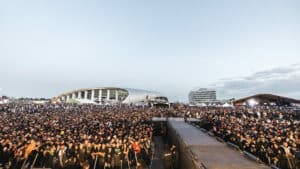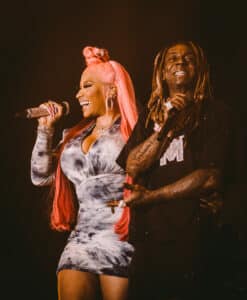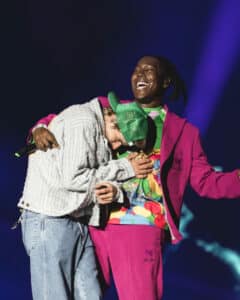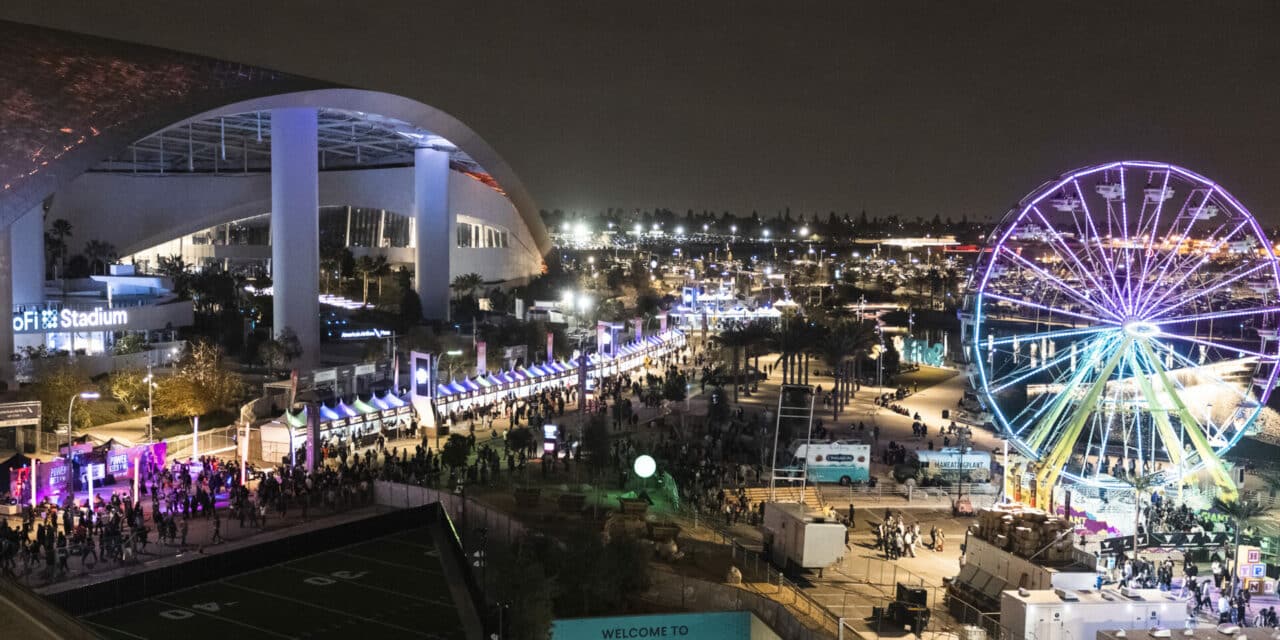SOFI-CHELLA: The 2023 Rolling Loud fest featured a small amusement park area called “Hypland” which included a Ferris wheel, not unlike the one you see at Coachella. (Steve Thrasher Photo)
Event produced in tandem with the facility’s operations team
INGLEWOOD, CALIF. — This past weekend was a good one for music festival fans across Los Angeles County and beyond as a new site came online. Hollywood Park, the 300-acre still-in-development area surrounding SoFi Stadium in Inglewood, hosted Rolling Loud, the global hip-hop festival brand. Its successful first use case at Hollywood Park bodes well for the site hosting future festivals.
The sold-out festival, which hosted 60,000 fans a day, felt comfortably full on Saturday (March 4), the second day of the three-day festival. The fest’s featured headliners included Lil Wayne, Future, Playboi Carti and Travis Scott along with major draws like Saweetie, Lil Baby, Don Toliver, 2 Chainz, Lil Uzi Vert, Lil Yachty, Tyga, Soulja Boy and others. There were also several special guest appearances including Justin Bieber, James Blake and Kali Uchi (Toliver), Niki Minaj (Lil Wayne), ASAP Ferg (Future) and YG (Tyga)
“It was always our intent to bring festivals to [Hollywood Park] and to do it with a festival like Rolling Loud,” said Adolfo Romero, vice president of programming and booking at SoFi, YouTube Theater and Hollywood Park, before Sunday’s proceedings, who noted his team has been working on hosting a festival with the city of Inglewood since SoFi’s inception.

HOW THEY ROLL: Rolling Loud’s featured headliners included Lil Wayne, Future, Playboi Carti and Travis Scott along with major draws like Saweetie, Lil Baby, Don Toliver, 2 Chainz, Lil Uzi Vert, Lil Yachty, Tyga, Soulja Boy and others. (Steve Thrasher)
Surveying the festival grounds, the site was well-organized with safe ingress and egress, good traffic flow, spacious open areas, relatively short concessions lines, a number of major brand activations (including Google Pixel, Forever 21, Monster Energy Drink, Liquid Death and Born X Raised), a small amusement park as well as three branded stages including the largest, the Levi’s Stage, along with the Gopuff and Culture Kings Stages.
A large VIP area, that could host thousands, was offered as an add-on and took up a large swath of the stage right area of the Levi’s Stage. It was something of its own universe unto itself featuring a barber shop, tattoo parlor and an amusement attraction as well as access to the front of the stage and another premium ticketed grandstand area.
While moshing during many contemporary hip-hop artists’ sets has become de rigueur, Rolling Loud, which is partners with Live Nation, was vigilant in its crowd management, especially in the wake of the crowd surges at 2021’s Astroworld which suffered eight fatalities. Artists, including Playboi Carti and Don Toliver, paused their sets to ensure fan safety. Also, a large barricaded corridor in the center of the crowd was in place to mitigate surges. Scott’s set also cut off the sound at its scheduled time seemingly stopping before the artist had finished due to his late start time.
Romero credits the festival’s successes to the “collaboration between our partners, Rolling Loud and the City of Inglewood,” whose mayor James T. Butts was introduced by festival co-founder Tariq Cherif before Tyga’s set. “We started these discussions very, very early in the planning when we were completing the stadium,” Romero says referring to the $5.5. billion building’s September 2020 opening. “As Hollywood Park was coming to life, we started discussions with the city about different festival models.”

Barbie & Weezy: Nicky Minaj joined Lil Wayne on stage at Rolling Loud on Saturday night. (Courtesy Rolling Loud)
Much like how the NFL took over SoFi during Super Bowl LVI, Rolling Loud produced the festival in tandem with the facility’s operations team. “Everything was contracted directly through Rolling Loud,” Romero says. “They came in and took over the space and we worked alongside them to make sure that their plans were aligned with ours in terms of what we were doing within the site. They used a lot of our best practices and everything was submitted to the city and then the city worked alongside us.”
All said, there is still room for improvement. The long corridor between stages circled one side of the stadium parameter and at times felt overly crowded. The corridor should be widened. Lines at the merch booth and some food concessions were long, which unfortunately is normal for most festivals.
The VP of programming also explained that the festival footprint can be easily altered. “That’s one of the unique options we have here,” he said. “For this weekend, our capacity is at 60,000, but, as you probably got to experience, the site can present itself in different ways where you can have different configurations with a one-day festival for 20 or 30,000 or as small as 15,000. We have 70,000 fans coming into the site on any given Sunday or weekend and this is less than that so the infrastructure already exists for us to be able to bring people in here in a smooth way.”
When asked about using the SoFi, YouTube Theater or the American Airlines Plaza for future fests, the booking executive says it’s very possible. “I think the long-term vision is to figure out ways that we can activate those spaces. If it’s not something inside, maybe it’s food or a VIP space inside the stadium—that’s what we’re looking at, how can we activate and do more unique experiences.”

GOOD VIBES: Justin Bieber hugs Don Toliver at Rolling Loud outside SoFi Stadium at Hollywood Park. (Courtesy Rolling Loud)
It should be noted that festivals, as many promoters will tell you, are hard, especially in Los Angeles with its vast distances, spotty public transportation and often exorbitant parking. Over the years in SoCal, many festivals have come and gone from the market, including FYF Fest, Made In America, Lollapalooza, Camp Flog Gnaw (which may return), Electric Daisy Carnival, Sunset Strip Festival and Together As One among others.
Part of this may have to do with the red tape this city and state are famed for. But also some of the sites in or near L.A. County are a mixed bag. This includes Exposition Park surrounding Memorial Coliseum (good luck parking); Los Angeles State Historic Park next to Chinatown (a serpentine layout but solid public transport options); Brookside, on the back side of Pasadena’s Rose Bowl (a trek from some) and Dodger Stadium’s parking lot. Further afield is Redondo Beach in the South Bay which has hosted BeachLife Festival since 2019; and Dana Point in Orange County which since 2016 has staged the Ohana Festival.
There may also be some degree of saturation in the market, too, with new quality fest market entrants: This Ain’t No Picnic (Goldenvoice/AEG), which was held at Brookside by the Rose Bowl; and Primavera Festival (Live Nation) at L.A. State Park. Both were exquisitely programmed with fantastic music but were inexplicably less than full. Hopefully, both return. Besame Mucho, a Latin music festival that debuted last December at Dodger Stadium, is already slated to come back next year.
Meanwhile, Hollywood Park is still being developed with 25,000 new residencies, retail, office spaces, hotels and restaurants (Cosm, an immersive venue is slated to open there this year), and when completed will be the largest urban mix use mega-development in the western U.S. The site is also situated near several freeways and has a manmade lake on one side that makes the asphalt areas feel less like parking lots.
Sunset vistas of the Ferris wheel and amusement rides against the torqued glimmering SoFi at sunset, as well as a view of the soft glowing Kia Forum past dusk, evoked nothing so much as Coachella. Clearly, the Hollywood Park site is not in the same league as the mega-fest standard bearer, but for many fans of contemporary hip-hop this past weekend’s gathering was as good as it gets and the site certainly helped facilitate that experience.







